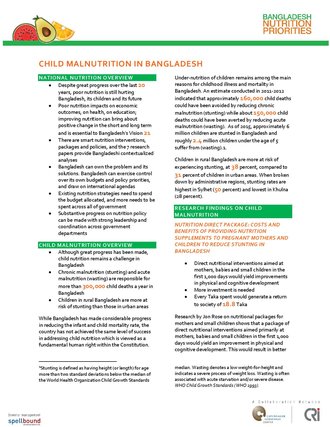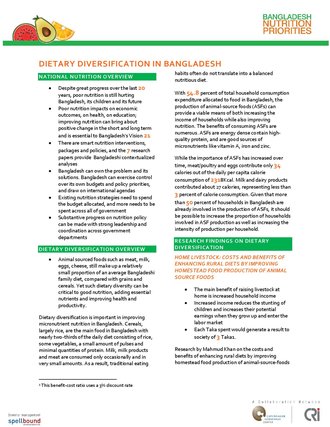Bangladesh Nutrition - Policy Briefs
Policy Brief on Child Malnutrition in Bangladesh
 This brief identifies the detrimental impact that poor nutrition continues to have on the health and education of Bangladeshi children, along with their economic implications. The brief outlines those solutions proposed by researchers with expertise in child nutrition. One intervention suggests the use of a nutrition package comprised of nine interventions that are to be administered to mothers, babies and small children in the first 1,000 days of life. The second intervention evaluates what benefits the promotion of nutritious foods might have in improving the health and nutritional status of women, infants and young children.
This brief identifies the detrimental impact that poor nutrition continues to have on the health and education of Bangladeshi children, along with their economic implications. The brief outlines those solutions proposed by researchers with expertise in child nutrition. One intervention suggests the use of a nutrition package comprised of nine interventions that are to be administered to mothers, babies and small children in the first 1,000 days of life. The second intervention evaluates what benefits the promotion of nutritious foods might have in improving the health and nutritional status of women, infants and young children.
Download the entire brief here.
Policy Brief on Maternal Nutrition and Pregnancy in Bangladesh
 While Bangladesh has done much to reduce its maternal and infant mortality rates over the last several decades, mother and child undernutrition, even among wealthy populations remains a concern. The brief outlines the research findings of two studies that propose solutions in improving maternal nutrition and pregnancy in Bangladesh. The first study evaluates the costs and benefits of an intervention designed to change the behavior of pregnant women to stop consuming smokeless tobacco during pregnancy. The second study focuses on the costs and benefits of three key nutrition supplements during pregnancy – calcium supplementation, balanced energy protein supplementation and iron-folate supplementation.
While Bangladesh has done much to reduce its maternal and infant mortality rates over the last several decades, mother and child undernutrition, even among wealthy populations remains a concern. The brief outlines the research findings of two studies that propose solutions in improving maternal nutrition and pregnancy in Bangladesh. The first study evaluates the costs and benefits of an intervention designed to change the behavior of pregnant women to stop consuming smokeless tobacco during pregnancy. The second study focuses on the costs and benefits of three key nutrition supplements during pregnancy – calcium supplementation, balanced energy protein supplementation and iron-folate supplementation.
Download the entire brief here.
Policy Brief on Dietary Diversification
 While dietary diversification is critical to good nutrition, adding essential nutrients and improving health and productivity, two-thirds of the average Bangladeshi family diet consists of cereals like rice. The brief outlines the research findings of two studies that propose solutions in improving Bangladesh’s micronutrient nutrition needs. The first study evaluates the costs and benefits of increasing homestead production of animal-source-foods as a means to increase household income and subsequent nutritional status. The second study focuses on the costs and benefits of promoting complementary and supplementary feeding among women and children. Complementary feeding refers to the introduction of family foods which usually occurs in infants from 6-24 months of age. Supplementary feeding refers to those foods high in vitamins, minerals, fiber, fatty acids and amino acids that would otherwise not be consumed in sufficient quantities.
While dietary diversification is critical to good nutrition, adding essential nutrients and improving health and productivity, two-thirds of the average Bangladeshi family diet consists of cereals like rice. The brief outlines the research findings of two studies that propose solutions in improving Bangladesh’s micronutrient nutrition needs. The first study evaluates the costs and benefits of increasing homestead production of animal-source-foods as a means to increase household income and subsequent nutritional status. The second study focuses on the costs and benefits of promoting complementary and supplementary feeding among women and children. Complementary feeding refers to the introduction of family foods which usually occurs in infants from 6-24 months of age. Supplementary feeding refers to those foods high in vitamins, minerals, fiber, fatty acids and amino acids that would otherwise not be consumed in sufficient quantities.
Download the entire brief here.
Policy Brief on Girls Education and Nutrition
 Low participation in secondary schooling among girls is attributable to the rise in marriage and subsequent high-dropout rate and the role of girl’s education in the labor market. As a result, the poor nutritional status of children is strongly associated with mothers with low levels of education. The brief outlines the research findings of two studies that identify potential solutions for improving education and nutrition among girls. The first study evaluates the costs and benefits of providing stipends to encourage girls to enroll and stay in school, suggesting that additional schooling would potentially lead to increased earnings. The second study focuses on secondary schooling for girls as a solution to child malnutrition. The research suggests that a high level of education results in better knowledge and awareness of health and nutrition.
Low participation in secondary schooling among girls is attributable to the rise in marriage and subsequent high-dropout rate and the role of girl’s education in the labor market. As a result, the poor nutritional status of children is strongly associated with mothers with low levels of education. The brief outlines the research findings of two studies that identify potential solutions for improving education and nutrition among girls. The first study evaluates the costs and benefits of providing stipends to encourage girls to enroll and stay in school, suggesting that additional schooling would potentially lead to increased earnings. The second study focuses on secondary schooling for girls as a solution to child malnutrition. The research suggests that a high level of education results in better knowledge and awareness of health and nutrition.
Download the entire brief here.

